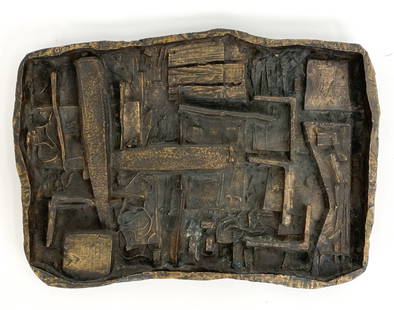
A LURISTAN BRONZE 'DOUBLE IBEX' FINIAL, IRAN, CIRCA 1350-1000 BC
Similar Sale History
View More Items in Sculptures & CarvingsRelated Sculptures & Carvings
More Items in Middle Eastern Sculptures & Carvings
View MoreRecommended Art
View More












Item Details
Description
Finely cast in the form of two confronted rampant ibexes, with curved horns, long erect ears, and short tails. With an associated pin, neatly incised with geometric decorations, dating from the same period.
Provenance: Galerie Persepolis, Brussels, exhibited from 28 October to 13 November 1971. Collection Monsieur H., Brussels, acquired from the above. Collection Madame D.T., acquired from the above.
Condition: Good condition, commensurate with age. Extensive wear, few nicks, light scratches, minor losses, signs of weathering and corrosion, and encrustations.
Weight: 49.5 g (the ibex finial) and 19.5 g (the pin)
Dimensions: Height 8.4 cm (excl. stand) and 17.2 cm (incl. stand)
With a modern metal stand. (3)
Luristan bronzes are small cast and decorated objects from the Early Iron Age (first millennium BC) which have been found in large numbers in Lorestan province and Kermanshah in western Iran. They include a great number of ornaments, tools, weapons, horse fittings, and a smaller number of vessels including situlae and are characterized by a wide range of idiosyncratic forms and a highly stylized conception of human and animal representation. Those from recorded excavations were generally found in burials. The ethnicity of the people who created them remains unclear, though they may well have been Iranian, possibly related to the modern Lur people who have given their name to the area. Luristan bronze objects came to the notice of the world art market from the late 1920s onwards. They were excavated in considerable quantities by local people and are found today in many of the world's most important museums.
Literature comparison:
Compare a closely related Luristan bronze finial in the form of confronted two ibexes, 10 cm high, dated 1000-800 BC, in the Louvre, inventory number AO 20503. Compare a closely related Luristan bronze standard finial, 11.5 cm high, dated circa 1350-800 BC, in the Los Angeles County Museum of Art, accession number M.76.97.48.
Auction result comparison:
Type: Related
Auction: Sotheby's New York, 7 June 2007, lot 86
Price: USD 12,600 or approx. EUR 16,500 converted and adjusted for inflation at the time of writing
Description: A Luristan bronze finial, circa 800 BC
Expert remark: Note the size (18.1 cm)
Buyer's Premium
- 30%
A LURISTAN BRONZE 'DOUBLE IBEX' FINIAL, IRAN, CIRCA 1350-1000 BC
Shipping & Pickup Options
Item located in Vienna, Vienna, atPayment































































![[SEX] LOT OF 9 PHOTOGRAPHS SOLD TOGETHER: [SEX] A lot of 9 photographs sold together. Some postcards. One mounted with plastic corners in archival mat. Prints: 4.5" x 3" - 6" x 4". Generally good condition, various imperfections. *Additional](https://p1.liveauctioneers.com/8124/329546/177689790_1_x.jpg?height=310&quality=70&version=1715469494)


![Emilio Grau-Sala "Sur la Plage" Oil on Canvas: Emilio Grau-Sala (Spanish, 1911-1975), "Sur la Plage" [On The Beach], Oil on Canvas, 1958, signed "Grau Sala" lower right, signed, inscribed "Trouville", dated, and titled to verso. Image: 21.5" H x 2](https://p1.liveauctioneers.com/5649/328023/176731071_1_x.jpg?height=310&quality=70&version=1714409606)











